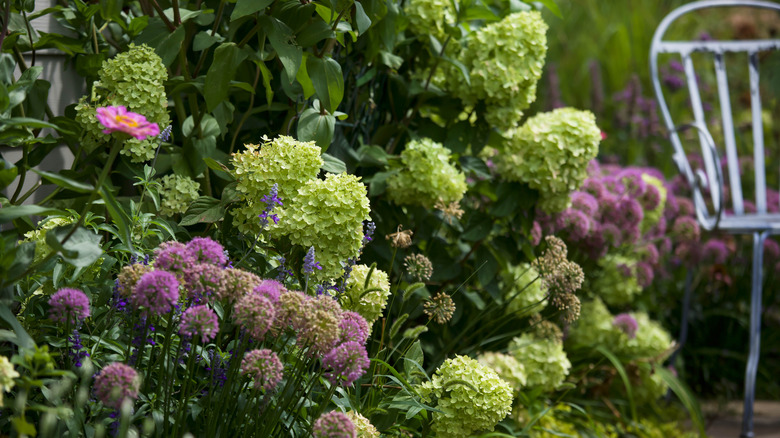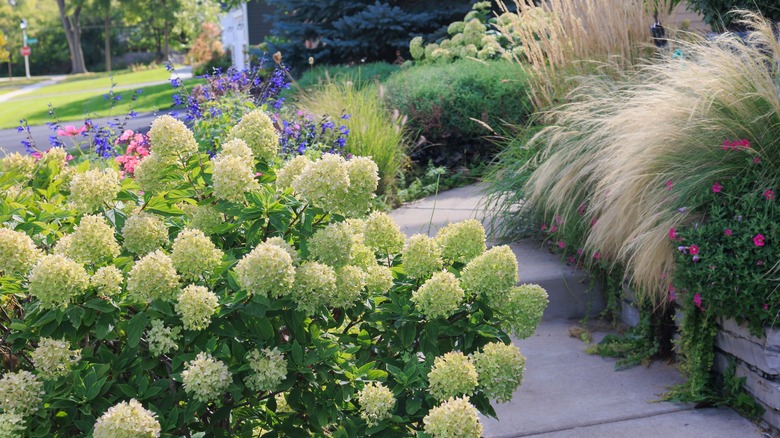The Benefits Of Planting Limelight Hydrangeas Near Alliums In The Garden
Some plants are simply a match made in heaven and the pairing of 'Limelight' hydrangeas (Hydrangea paniculata 'Limelight') and alliums, as demonstrated by TikToker @hagenbakhuset, is no exception. There are plenty of benefits to planting your 'Limelight' hydrangeas near some colorful alliums to create an absolutely stunning display in your garden that will amaze your friends and family. When you pair these two stunning flowering plants, you'll get the benefit of having allium blooms while your hydrangeas are just displaying foliage, and your hydrangeas will be blossoming when your alliums are just left with strappy green leaves. In fact, alliums are one of a variety of flowers you'll adore if you love hydrangeas because their petals are similar and just as showy.
Both these plants need similar growing conditions and can be grown in either full sun or part shade. They also appreciate soil that is high in organic matter and will attract plenty of bees and butterflies to your garden. While it's commonly recommended that you mulch your 'Limelight' hydrangeas in order to conserve moisture, the foliage of the alliums will also help to shade the soil. Plus, the mulch will help to protect the bulbs over the colder months.
How alliums can add interest to your 'Limelight' hydrangea planting
Alliums are bulbs and are commonly referred to as ornamental onions. They come in a range of different flower colors such as purple, pink, red, white, and yellow and can be successfully grown in USDA hardiness zones 4 through 9. The flowers are globe-like and appear on tall stems and can reach a height of around 3 feet. Allium blooms appear in late spring through to early summer.
If you plan to keep your hydrangea trimmed to around the same height as the allium stems (which is fine for this cultivar, because they bloom on new growth) you can plant the allium bulbs around the base of your 'Limelight' hydrangea shrub. The allium flower stems will poke up through the hydrangea foliage and give the magical illusion that they're actually part of the same plant, similar to how it appears in the TikTok video.
This will provide your garden bed or border with some delightful color and added interest while you're waiting for the hydrangea blooms to appear and take over. The allium flowers will also help to keep visiting pollinators such as bees and butterflies happy. Plus, if you have a problem with deer, the onion scent omitted by the leaves of the alliums may help keep deer and rabbits away from your prized hydrangeas. Alliums are also one of several flowers you can grow to ward off bugs and other pests.
How hydrangeas help to disguise the foliage of alliums
Once alliums have finished flowering, you're left with just the leaves, which are often not that attractive. But if you know how to grow and care for 'Limelight' hydrangeas, you can pair these with your alliums so that the hydrangeas hide the bland foliage of the alliums, and start to put on their stunning floral display around the same time. This means that you don't have to cut back the allium leaves to keep your garden looking fresh.
'Limelight' hydrangeas can be grown in USDA hardiness zones 3 through 9 and have attractive flowers that start out as creamy white and change color to green and eventually pink as they mature. The flowers appear in summer and continue on into the fall. Your hydrangeas will start to bloom immediately after your alliums have finished their colorful floral display. You might even get lucky and have a few allium blooms remaining, and these will blend beautifully with the large hydrangea flowers.

